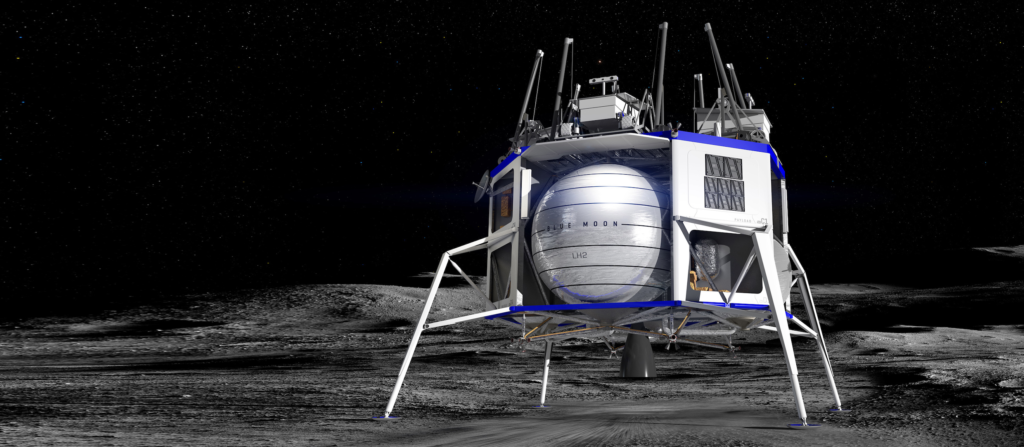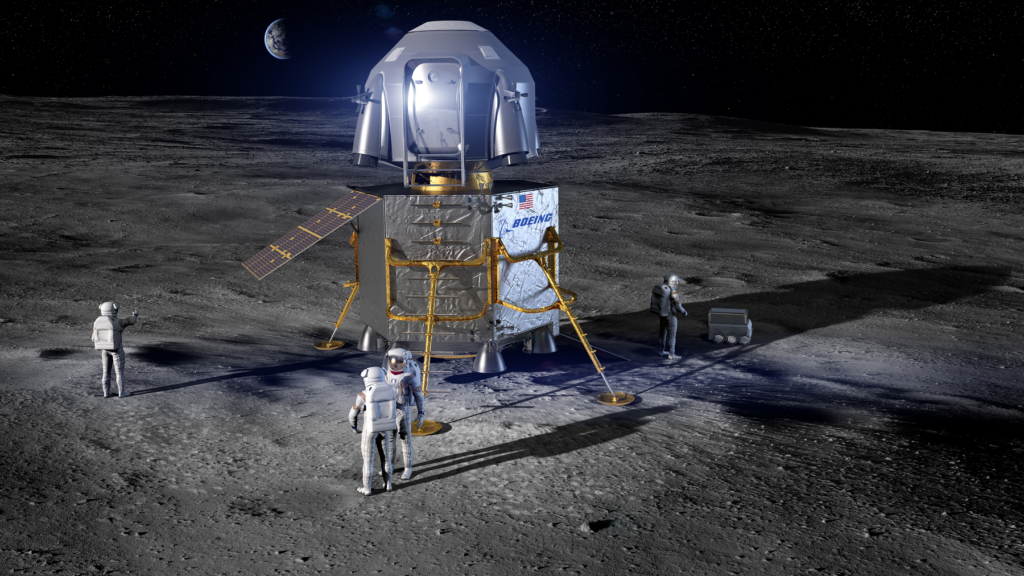
Blue Origin Continues To Work Toward A Moon Landing
Blue Origin is in the process of creating a lunar lander meant missions to and from the lunar surface. The goal is to create a lander capable of not only transporting payloads but humans as well. With future Artemis missions right around the corner, Blue Origin is hoping to have this capability for when the activity starts to ramp up.
Just yesterday, we got a new update on the Blue Moon lander’s progress. This came in the form of a new BE-7 engine test. Many people are aware of Blue Origin’s BE-4 engine for New Glenn and Vulcan, and the BE-3 used on New Shepard, but not the BE-7. Just one of these engines will provide propulsion for the main lander segment. An important job with very little room for error.
For years now both this engine and the Blue Moon lander have been under development. Despite this long time period, it’s very rare that Blue Origin releases updates on these different pieces of equipment. Here I will go more in-depth into the recent BE-7 test, what exactly Blue Origin’s plans are with Blue Moon, what to expect in the coming months, and more.
New BE-7 Test

Yesterday, Blue Origin released an update on the BE-7 engine with a TCA test video. They tweeted saying, “Last week, our BE-7 team conducted another successful Thrust Chamber Assembly (TCA) test at NASA Marshall Space Flight Center Test Stand 116. Our tests on an upgraded TCA bring our cumulative test time to more than 4000 seconds, and we are on track in our engine development path.” This included a 40 second video of the engine fire.
They also made a comment that “This was a self-funded test as part of our campaign to advance our lunar capabilities, and we’re grateful for our @NASA_Marshall partners.” The BE-7 engine is an additively manufactured, high-performance, dual-expander cycle engine, generating 40 kN (10,000 lbf) thrust. The company points out that the high specific impulse, deep throttling, and restart capabilities of the BE-7 make the engine ideal for large lunar payload transport, while enabling Blue Moon’s oxygen/hydrogen fuel cell power system.
While this update is great, it also brings up a few concerns regarding the timeline and development. All the way back in late 2020, Blue Origin kicked off the fourth thrust chamber test series of the BE-7. During this specific test, the thrust chamber was fired for a duration of 20 seconds. This brought the combined testing time on the BE-7 thrust chamber in 2020 to a total of 1,245 seconds. Almost 2 and a half years later and they are only surpassing 4000 seconds of test time with quite a bit of work ahead of them. While not ideal, they did mention that they were still on track in their engine development path.
Focusing back on the test footage, the senior vice president, Engines, Blue Origin said, “This thrust chamber test measured the ability to extract energy out of the hydrogen and oxygen cooled combustor segments that power the engine’s turbopumps – the key to achieving high engine performance. In addition, Brent Sherwood, vice president of Advanced Development Programs, Blue Origin commented, “The BE-7, a turbomachinery-based engine using the most efficient propellants, is optimal for deep-space maneuvers and landing on the Moon. Our engine test series is steadily maturing what’s needed to get Americans safely on the lunar surface as soon as possible. We are positioning to use the Moon’s ice resources for rocket propellant, which will make exploration sustainable and open the Moon for commerce.”
The recent test even got a comment from Tom Mueller. Tom Mueller is an aerospace engineer and rocket engine designer. He was a founding employee of SpaceX, and the founder and CEO of Impulse Space. In response to the BE-7 test fire, he replied “Too much film cooling”. Film cooling is the introduction of a secondary fluid (coolant or injected fluid) at one or more discrete locations along a surface exposed to a high temperature environment to protect that surface not only in the immediate region of injection, but also in the downstream region. Based on the entire fire and some of its features, he determined that there was still some work to do in that department.
Blue Moon & HLS

As partially mentioned prior, the BE-7 is the primary engine on the Blue Moon lander, and will also play an important role in Blue Origin’s HLS design. On Blue Origin’s website, they describe that “Blue Moon is a flexible lander delivering a wide variety of small, medium, and large payloads to the lunar surface. Whether cargo or crew, its capability to provide precise and soft landings will enable a sustained human presence on the Moon.”
The lander features a cargo lander variant, designed to provide reliable, repeatable, and cost-effective delivery of a wide variety of payloads to the lunar surface. Based upon configuration and mission, Blue Origin is hoping to land up to several metric tons of payload on the Moon, ranging from large rovers, habitats, and ascent stages. The service is also meant to facilitate greater opportunities to conduct science, in-situ resource utilization, infrastructure development, and logistics missions for government, academia, and commercial customers.
The lander is planned to be capable of delivering 4,500 kilograms (9,900 lb) to the surface of the Moon. The cargo vehicle could also be used to support NASA activities in cis-lunar space, or transport payloads of ice from Shackleton Crater to support space activities. Blue Origin began development work on the lander in 2016, publicly disclosed the project in 2017, and unveiled a mock up of the Blue Moon lander in May 2019. The first projected mission for the craft as of 2018 was to have been a 2024 lunar south pole region landing, where it was proposed that a series of landings could be used to deliver the infrastructure for a Moon base. A second potential use was as a part of a NASA-funded Integrated Lander Vehicle (ILV) effort in 2020 that would have carried humans to the Moon; but NASA did not select the ILV design for further funding in the April 2021 selection for the Artemis HLS program.
In October 2019, it was announced that Blue Origin, Lockheed Martin, Northrop Grumman and Draper Laboratory would collaborate to create a proposal for the “Human Landing System” (HLS) for NASA’s Artemis program, with Blue Origin serving as the primary contractor with a variation of its Blue Moon Lunar Lander serving as the descent stage. Lockheed Martin would build the ascent stage, in part based on its Orion crew capsule technology. Northrop Grumman would build a transfer stage based on its Cygnus spacecraft technology. The lander was projected to launch on Blue Origin’s reusable New Glenn rocket. In April 2020, Blue Origin won a design contract of US$579 million from NASA to advance the design of a human lunar lander for the Artemis program during a 10-month period in 2020–21.
Blue Origin’s proposal—submitted along with several large US government space contractors including Lockheed Martin, Northrop Grumman, and Draper Laboratory, each acting as a subcontractor to Blue Origin who was to provide the descent element and also be the integration lead—was for the Integrated Lander Vehicle (ILV), a multi-element spacecraft consisting of an in-space transfer element and ascent element in addition to the Blue-provided descent element. The NASA paid design work started in 2020 and continued into 2021, when NASA was to evaluate which contractors would be offered contracts for initial demonstration missions and select firms for development and maturation of lunar lander systems. Eventually, NASA picked Starship and since then the HLS team has changed and they are hoping to win the next available contract.
Specifically, The National Team of Blue Origin, Lockheed Martin, Draper, Boeing, Astrobotic, and Honeybee Robotics is competing for a NASA Sustaining Lunar Development contract to develop a human landing system for the Artemis program. In partnership with NASA, this team will achieve a sustained presence on the Moon. Taking a closer look at Blue Moon, the top deck and lower bays are designed to easily accommodate a wide variety of payloads, including large payloads and ESPA-class payloads with standard ring port interfaces. There are lower mounting locations for payloads, useful for closer access to the lunar surface and off-loading. The Blue Moon lander provides kilowatts of power to payloads using its fuel cells, allowing for long mission durations and the ability to last through the lunar night. The lander is also designed with precision guidance and descent sensors that utilize machine learning technology to accurately land anywhere on the lunar surface, starting with its first mission.
Unfortunately, besides this recent BE-7 test, we have heard very little about either Blue Moon, or the SLD National Team. Months ago in December of last year, the Team submitted its proposal for NASA’s SLD program to help the US establish a sustained lunar presence. Right now, we will just have to wait to see how both these programs develop and if Blue Origin is able to secure a significant contract for the future of Artemis and exploration on the Moon.
Conclusion
Blue Origin just recently completed another test of the BE-7 engine. This engine’s development is very important as both the Blue Moon lander and the larger variant for the SLD team rely on it. While testing has not been the fastest, Blue Origin says they are still on track in their engine development path. We will have to wait and see how it progresses and the impact it has on the space industry.
